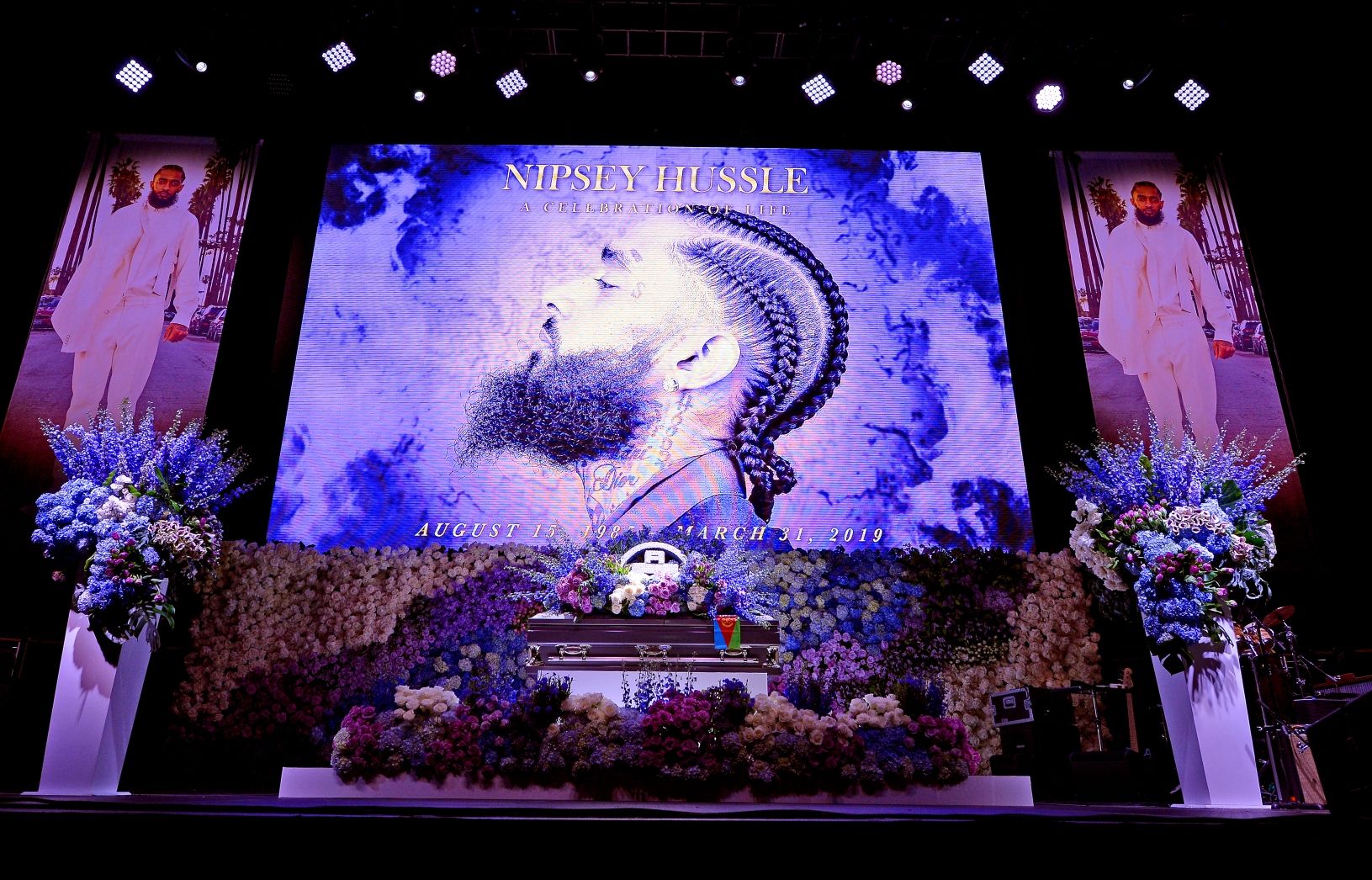Photo: Jorge Peniche
Introduction
Rapper and entrepreneur Nipsey Hussle, who was tragically murdered on March 31, 2019 while standing outside his clothing store in the Crenshaw neighbourhood of Los Angeles, was one of the first mainstream artists to talk about Bitcoin. Little has been said about the connection between Nipsey and Bitcoin. I would like to change that, because he had a very unique way of looking at life and Bitcoin, which allowed me to understand the significance of the technology. More on that later.
* Bitcoin the network = capital B
* bitcoin the currency = lower case b
Nipsey Hussle aka Ermias Joseph Asghedom was born on August 15,1985 and grew up in the Crenshaw area of south Los Angeles to an African American mother and Eritrean father. In 2010 I watched a video of a young Nipsey Hussle explaining the difference between assets and liabilities, which eventually led me to buying bitcoin years later. In the video, which you can watch below, Nipsey explains in an "easy-to-understand" language why owning cars, jewellery and other liabilities is a distraction and why we should focus on accumulating assets instead.
Nipsey Hussle on Hard Knock TV Vaults around 07
There are a few statements in the video I don’t agree with, especially the critique of capitalism. It is fair to say that young Nipsey was not right on all counts. But the essence of what is said is of great importance. As a 19-year-old fresh out of school, his message helped me get on the right path. At this time, most people around me began to spend their "first" money on cars and other consumer goods.
That never appealed to me and intuitively felt wrong. Nipsey's remarks confirmed my intuition and prompted me to look more deeply into wealth creation.
What I particularly liked about Nipsey was his authenticity. He spoke like a “street dude” but with the wisdom of an experienced entrepreneur.
Ultimately, his statements led me to deal intensively with my consumer behaviour, to question our existing monetary system and to be open to accepting Bitcoin.
Mailbox Money
Between my years at university (2012-2015), where I studied philosophy and ethics, business management and finally financial economics, I had several “points of contact” with Bitcoin. Nipsey's music and interviews always accompanied me.
Finally, in the spring of 2015, at the end of my master's degree in financial economics, I sat in my room, somewhat frustrated, thinking about the topic of my thesis while listening to Nipsey's album Mailbox Money (2014).
In the Outro of the song "That's How I Knew," he addresses the technological changes that were imminent at the time (min. 2:45):
„Life, and it's like, you know,
You can look a gift horse in the face and not know what you lookin' at
And I feel like, you know, I'm lookin' at the gift horse
I'm just one of the ones that notice what I'm lookin' at
You know what I mean? It's actually an incredible time
It's like a gold rush, it's never been a time like this in our generation
It's our equivalent of the Gold Rush with everybody movin' to California
This technology has empowered everybody
And it's giving people, you know, it's as big as you wanna make it and
You know, it's as far as you take it
And we can quote a gang of things going on in the world right now
Or just, you know, accept it as being true
But, you know, it's like, man, giants gon' crumble
Big-big companies gon' crumble
New companies gon' pop up outta nowhere and it's-it's gon' be dramatic
And I believe that“
Nipsey Hussle - "That's How I Knew" (Mailbox Money, 2014)
As I sat there and thought about my thesis, it hit me like lightning. When I was dealing with Bitcoin, it always felt like I'm lookin' at the gift horse, even if no one around me thought the same. Plus, it really was like a gold rush. Between 2012-2013, bitcoin went from ∼12 $ to ∼1000$ in less than two years.
The wonderful thing about it was that everyone could take part. As Nipsey said This technology has empowered everybody. Even though he wasn't specifically talking about Bitcoin, but about technology in general, he inspired me to get more into it. The final product was my master's thesis "Bitcoin: A qualitative study of a monetary alternative: It’s value and applications." (2015). The first master thesis on Bitcoin in the field of financial economics in Europe.
Proud-2-Pay
Shortly after, Nipsey started talking specifically about Bitcoin and its potential to create an open financial system. As a young artist from Crenshaw he was faced with many adversities and found creative ways to deal with them. In the early 2010’s it was difficult to make money from music, as decentralised file sharing networks like Limewire and Napstar enabled consumers to download MP3 files for free.
Nipsey developed a concept he called "Proud-2-Pay” to empower the artist, which was frankly the predecessor to Value-4-Value. He always gave back to his community and wanted to show that his people would support him in return.
The campaign focused on his mixtape Crenshaw (2013). He offered the mixtape online for free, but also created 1,000 signed physical copies and charged $100 for them. Every single copy was purchased in less than 24 hours. Nipsey achieved his goal of sparking a discussion about artistic genius and freedom and proved that his community would always support him. At the time, he was an up-and-coming artist. The campaign was a great success and generated many positive reactions. Rap mogul Jay Z, for example, bought 100 copies of his $100 CD Crenshaw.
“It was a concept. It was basically like, always by choice, never by force. If you are proud to pay for it, this is the price of it.” - Nipsey Hussle (2013)
Value-4-Value
Value-4-Value is the idea that you pay for content you find valuable. The idea is simple but sounds radical: you provide your content for free, for everyone, without access restrictions. If people enjoy it, if people get value out of it, you make it easy for people to give value back (Gigi).
Until now, we have relied on third parties, paywalls, advertising and data as online payment methods. From now on, we have the option to send value in the form of bitcoin or satoshi, the smallest denominator of bitcoin.
In 2013, Nipsey was still using the traditional transaction model. But as far as I know, he was one of the first artist to offer a kind of Value-4-Value model. Nipsey’s legacy embodies the “Bitcoin Mindset.” Freedom, prosperity, creativity, justice and community building for a meaningful analog existence in a digital world.
The Marathon
Unlike other artists, Nipsey prided himself on never leaving his community. Instead, he bought an entire block in his Crenshaw neighbourhood and improved it by, among other things, opening a store there for his clothing line, The Marathon. The brand represents his attitude. Life is not a sprint, but a marathon.
Longevity is also the ethos of Bitcoin. The supply is fixed at 21,000,000. There will never be more. This certainty and the fact that Bitcoin allows the value of work to be preserved makes it possible to save and plan for the future.
All Money In
All Money In is the name of the record label and concept that Nipsey launched with his brother Blacc Sam in 2010. The brand represents their unique way of thinking. Saving to build something that has “substance” in the long term. In 2010, at the time of a hip-hop culture all about fast living and materialism, this was revolutionary. And that's what Nipsey Hussle was. A revolutionary. A revolutionary who left this earth far too early.
Nispey's death
Nispey's sudden death in 2019 was mourned around the world. Rarely have I seen so much sympathy for someone who passed. At the time he was just breaking into the mainstream. As a musician and entrepreneur. Unfortunately, it was only after his death that the public realized what a special human being he was.
In addition to being a musician, he had multiple businesses. A start-up accelerator in his neighborhood to offer new opportunities to young people from disadvantaged households. A real estate company. A fashion company. A record label,- and a technology venture focused on Bitcoin and blockchain. Nipsey was a visionary.

Nipsey thought deeply about social issues. He was well aware of the connection between poverty and crime. When people have no money, access to the financial system, or means to save and build wealth, they become pessimistic about the future and develop a high time preference. This means, for example, consuming today instead of saving for the future, which prevents people from thinking long term - and in extreme cases leads to the commission of crimes, even if this has no long-term benefit. Nipsey called it “getting in survival mode”. These are structural problems related to our monetary and financial system.
Getting out of survival mode
Historically, when governments or central banks fail with their monetary policy, they cling to power by printing money to continue funding their activities. The population then suffers from currency devaluation, price inflation and the resulting uncertainty. While Nipsey also linked the issues he raised to other structural problems in society, he understood that Bitcoin offered a solution.
The Bitcoin network is decentralised across thousands of computers around the world. No single entity controls it. The network is permissionless and accessible. There is no discrimination based on opinion, race, gender or origin and with that, Bitcoin has the potential to create a fairer society with a more equitable distribution of wealth.
As Nipsey predicted, the big banks are failing while Bitcoin is getting stronger and stronger. The marathon continues. We are just getting started. Rest in peace.
#TMC
Nipsey Hussle Interview - Escaping Survival Mode, Economics, & Master Your Energy
Nipsey Hussle - How to Grow Your Mindset and Achieve Your Dreams
Value 4 Value | Tips:
If you enjoyed this article, I’d appreciate it if you’d honor my time and effort by sending me some sats to law@getalby.com.
You can also follow me on Nostr: npub1v5k43t905yz6lpr4crlgq2d99e7ahsehk27eex9mz7s3rhzvmesqum8rd9
Twitter or visit my homepage.

Leon Wankum
Bitcoin. Real Estate. Philosophy & Ethics. npub1v5k43t905yz6lpr4crlgq2d99e7ahsehk27eex9mz7s3rhzvmesqum8rd9
follow me :




Related Posts
TOP 5 BTCSONGS 4 BCNPLEBS
Jun 18, 2024